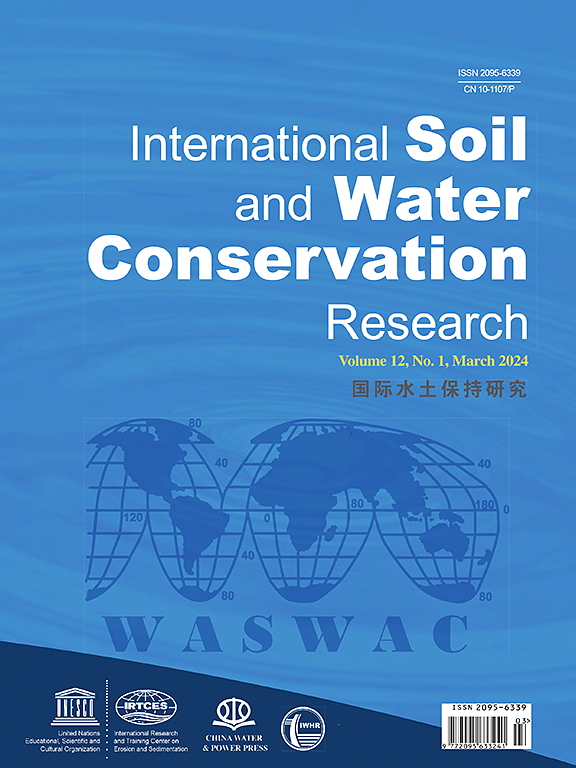The evolution of large gullies in association with long-term rainfall in the Tsitsa River Catchment, Eastern Cape, South Africa
IF 7.3
1区 农林科学
Q1 ENVIRONMENTAL SCIENCES
International Soil and Water Conservation Research
Pub Date : 2025-02-15
DOI:10.1016/j.iswcr.2025.02.004
引用次数: 0
Abstract
Large gullies exist as permanent features in the landscape that impact the surrounding environment and communities. The effect of rainfall on long-term gully evolution is still understudied, especially for large gully systems. The extent of the growth of the gullies of four large gullies in the Eastern Cape Province (South Africa) is explored over a 70-year period (1950–2020) in relation to rainfall. The extent of these gullies was mapped by manually digitizing the gully edges using aerial surveys and SPOT images captured during the study period. Daily rainfall depths were assessed to examine intense rainfall and rainfall erosivity values using the modified Fournier index. The results reveal an exponential trend of the evolution of the gully in which two phases of development of the gully occurred, according to the type of erosion processes that occurred. The first phase (1950–2004) was mainly characterised by the linear lengthening of the gully systems. The second phase (2004–2020) is mainly characterised by the initiation and growth of side branches in the gullies, with greater increases in extent. Both phases recorded highly erosive rainfall. It is postulated that gully expansion accelerated in Phase 2 due to land degradation resulting from increased livestock in the area. This study highlights that intense rainfall, while acting as a driver for gully expansion, is influenced by interconnected factors, including vegetation cover removal and topography. The findings of this study have implications for the results of control measures in large gully systems with dispersive soils.
大型沟壑的演变与长期降雨在Tsitsa河流域,东开普省,南非
大型沟渠作为景观中的永久特征存在,影响着周围的环境和社区。降雨对长期沟壑演变的影响仍未得到充分研究,特别是对大型沟壑系统的影响。研究了东开普省(南非)四个大沟壑的增长程度,研究了70年来(1950-2020年)与降雨的关系。这些沟壑的范围是通过使用航空调查和研究期间捕获的SPOT图像对沟壑边缘进行人工数字化来绘制的。利用改进的富尼尔指数评估日降雨深度,以检验强降雨和降雨侵蚀力值。结果表明,根据所发生的侵蚀过程的类型,沟的演变呈指数趋势,沟的发育经历了两个阶段。第一阶段(1950-2004)的主要特征是沟壑系统的线性延长。第二阶段(2004-2020年)以沟壑区侧枝的形成和生长为主要特征,范围增加幅度较大。两个阶段都录得高度侵蚀性降雨。据推测,由于该地区牲畜增加导致土地退化,沟谷扩张在第2阶段加速。该研究强调,强降雨虽然是沟壑扩张的驱动因素,但也受到植被覆盖去除和地形等相互关联因素的影响。本研究结果对具有分散性土壤的大型沟渠系统的控制措施的结果具有指导意义。
本文章由计算机程序翻译,如有差异,请以英文原文为准。
求助全文
约1分钟内获得全文
求助全文
来源期刊

International Soil and Water Conservation Research
Agricultural and Biological Sciences-Agronomy and Crop Science
CiteScore
12.00
自引率
3.10%
发文量
171
审稿时长
49 days
期刊介绍:
The International Soil and Water Conservation Research (ISWCR), the official journal of World Association of Soil and Water Conservation (WASWAC) http://www.waswac.org, is a multidisciplinary journal of soil and water conservation research, practice, policy, and perspectives. It aims to disseminate new knowledge and promote the practice of soil and water conservation.
The scope of International Soil and Water Conservation Research includes research, strategies, and technologies for prediction, prevention, and protection of soil and water resources. It deals with identification, characterization, and modeling; dynamic monitoring and evaluation; assessment and management of conservation practice and creation and implementation of quality standards.
Examples of appropriate topical areas include (but are not limited to):
• Conservation models, tools, and technologies
• Conservation agricultural
• Soil health resources, indicators, assessment, and management
• Land degradation
• Sustainable development
• Soil erosion and its control
• Soil erosion processes
• Water resources assessment and management
• Watershed management
• Soil erosion models
• Literature review on topics related soil and water conservation research
 求助内容:
求助内容: 应助结果提醒方式:
应助结果提醒方式:


